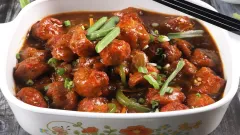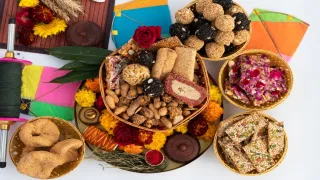Diwali, the festival of lights, is a celebration of joy, prosperity, and spiritual renewal. As families come together to light diyas and decorate their homes, the significance of welcoming Goddess Lakshmi, the embodiment of wealth and prosperity, takes centre stage. It is believed that on Diwali, Lakshmi visits every household to bless her devotees with abundance. To ensure her divine presence and blessings, offering her favorite foods as bhog or naivedyam is a cherished tradition.
The Legend of Goddess Lakshmi and Diwali
According to Hindu mythology, Goddess Lakshmi is the consort of Lord Vishnu, the preserver of the universe. The festival of Diwali marks the occasion of their marriage, symbolizing the union of wealth and divinity. The legend also states that during the Samudra Manthan (the churning of the ocean), Lakshmi emerged from the cosmic waters, bringing forth wealth and abundance. On this auspicious night, as the doors of homes are kept open to welcome her, devotees prepare an array of delectable offerings to honour her.
Foods That Please Goddess Lakshmi
Goddess Lakshmi, like many Hindu deities, has specific food preferences that devotees are encouraged to prepare and offer during Diwali. These foods not only signify respect and devotion but also symbolize various aspects of abundance, prosperity, and good fortune. Below are some of her favourite offerings:
1. Rice Kheer

Image Source: Twitter
Rice kheer, or payasam, is a beloved dish made from rice and milk, sweetened with sugar or jaggery. Known for its creamy texture and rich flavour, kheer is a staple during festivals and special occasions. Its preparation involves boiling rice in milk until it becomes soft and then adding sweeteners along with cardamom for aroma. This dish pays homage to Lakshmi who is often referred to as Annapurna, the goddess of food and nourishment. Some families may also opt to make a thicker variant known as phirni for a festive twist.
2. Foods with a Yellow Hue

Image Source: Twitter
In the spectrum of offerings, yellow foods hold a special place as yellow is considered Lakshmi's favourite colour. Foods that exhibit this vibrant hue symbolize auspiciousness and prosperity. Common offerings include:
- Bananas: These are always included in the blog, as they symbolize abundance.
- Mung Dal Khichdi: This comforting dish made with rice and mung beans is another favourite, often prepared in many households.
- Chana Dal Sweets: Sweet dishes made from Bengal gram and jaggery are particularly popular, especially in northern India.
- Pulihora: A tangy rice dish from South India, often made with tamarind and turmeric, reflecting the bright yellow colour.
3. Amla (Indian Gooseberries)

Image Source: Twitter
Few may know that Goddess Lakshmi has an affinity for amla or Indian gooseberries. According to mythology, amla was formed during the Samudra Manthan, and it is said that Lakshmi resides in the amla tree. Devotees offer amla leaves during the Hindu month of Mārgaśīrṣa to seek her blessings. This fruit not only has medicinal properties but also represents health and well-being, further aligning with the themes of prosperity.
4. Saffron

Image Source: Twitter
Among the world's most expensive spices, saffron (or kesar) is another ingredient that Lakshmi adores. Its rich flavour and vibrant colour make it a perfect addition to traditional Indian sweets. Some popular preparations include:
- Basundi Pulao: A sweet rice dish cooked with saffron and dry fruits.
- Kesar Peda and Kesar Laddoo: These sweets are delicately flavoured with saffron, elevating their taste and significance.
- Kesar Malpua: A sweet pancake infused with saffron and sugar syrup, offering a delightful treat.
- Sweet Saffron Rice: Rice cooked with saffron and mixed with nuts makes for a fragrant offering.
5. Sriphal (Coconut)

Image Source: Twitter
Coconut, known as Sriphal in Sanskrit, holds deep spiritual significance in Hinduism. The term "Sri" refers to Lakshmi, symbolizing prosperity, while "phal" translates to fruit. Coconut is easily available and embodies nourishment and abundance. During Diwali, coconut laddoos, often made with khoya and sweetened with jaggery, are popular offerings that celebrate both simplicity and richness. These laddoos are a must-have during Dhanteras and the Lakshmi Puja.
The Symbolism of Offerings
The act of offering food to Goddess Lakshmi extends beyond mere ritual; it is imbued with meaning. For instance, the tradition in Maharashtra involves hanging a lemon and seven chillies over the threshold. This is meant to appease Alakshmi, the goddess of strife, ensuring she stays outside while Lakshmi enters. Such practices highlight the intricate balance of energies that festivals like Diwali embody, reminding us to welcome positivity while warding off negativity.
Also Read: When is Diwali 2024: Date, timings, significance, and more






















